Abstract
One oft-cited problem with teaching speech skills to autistic children is the failure of the speech to be spontaneous. That is, the children's speech often remains under the control of the verbal behavior of others rather than under the control of other nonverbal referents in the environment. We investigated the effectiveness of a time delay procedure to increase the spontaneous speech of seven autistic children. Initially, the experiment presented a desired object (e.g., cookie) and immediately modeled the appropriate response "I want (cookie)." Gradually, as the child imitated the vocalization, the experimenter increased the time between presentation of the object and the modeled vocalization in an attempt to transfer stimulus control of the child's vocalization from the experimenter's model to the object. Results indicated that all the children learned to request items spontaneously and generalized this behavior across settings, people, situations, and to objects which had not been taught. These results are discussed in relation to the literature on spontaneous speech, prompting, and generalization.
Full text
PDF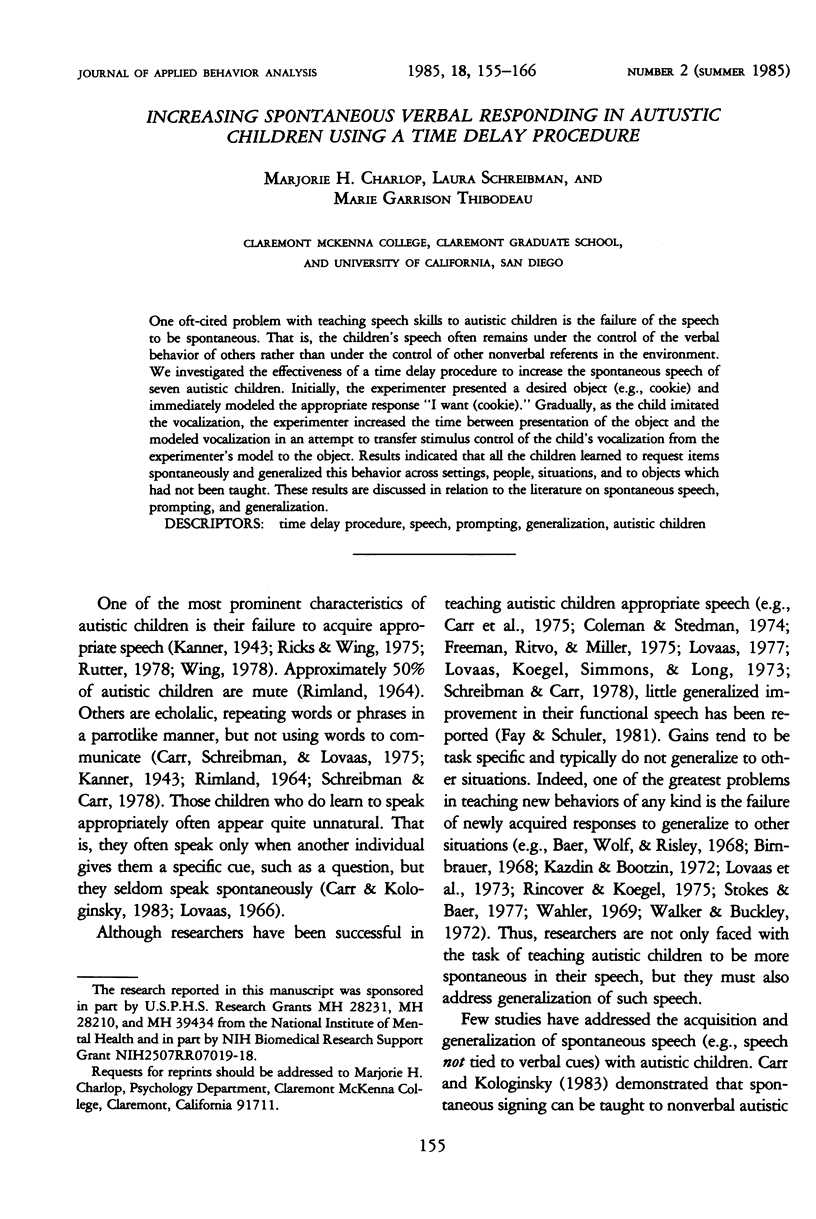
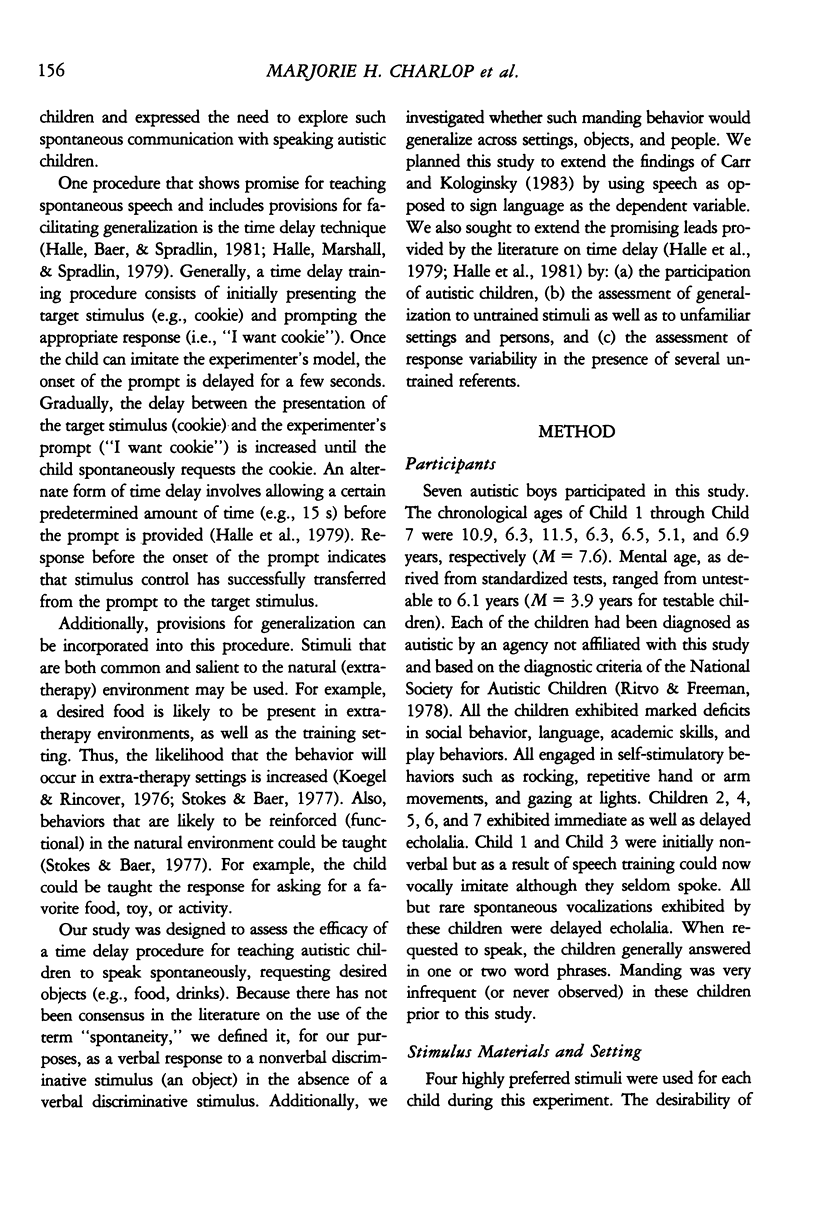
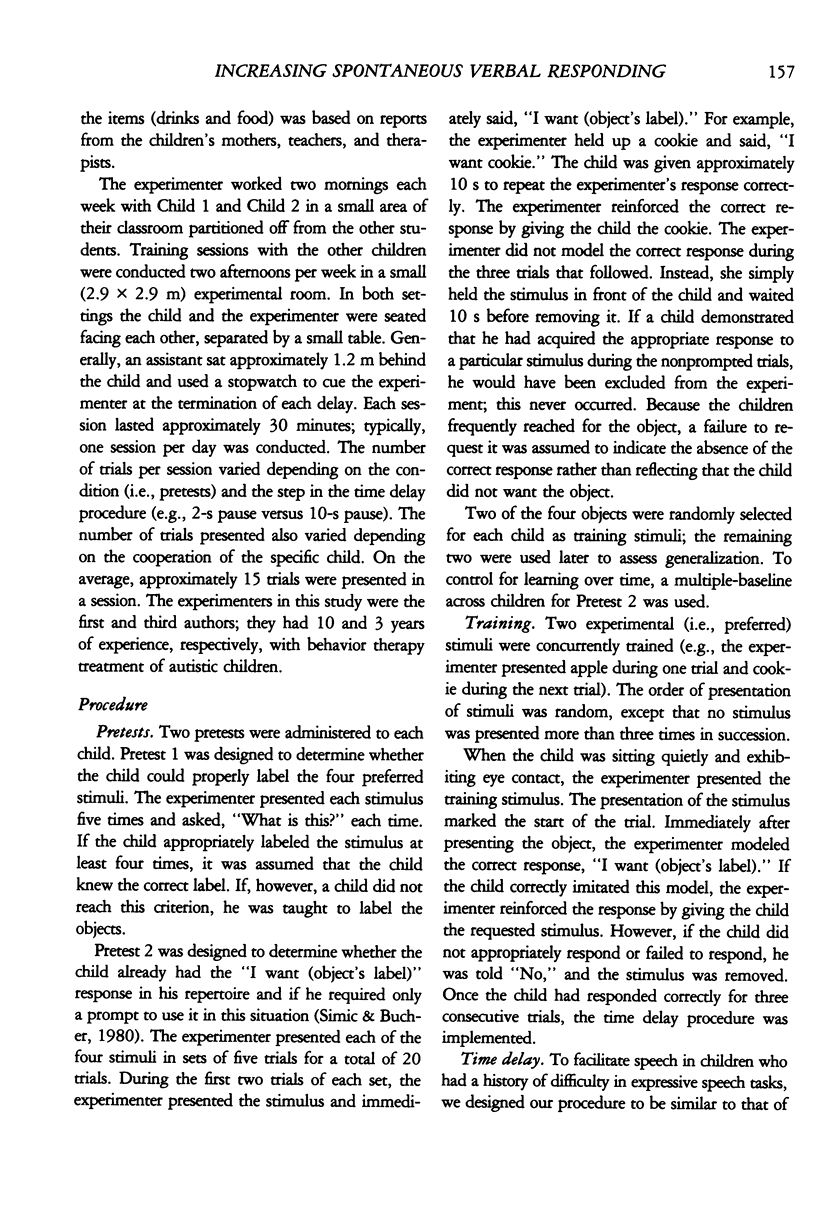
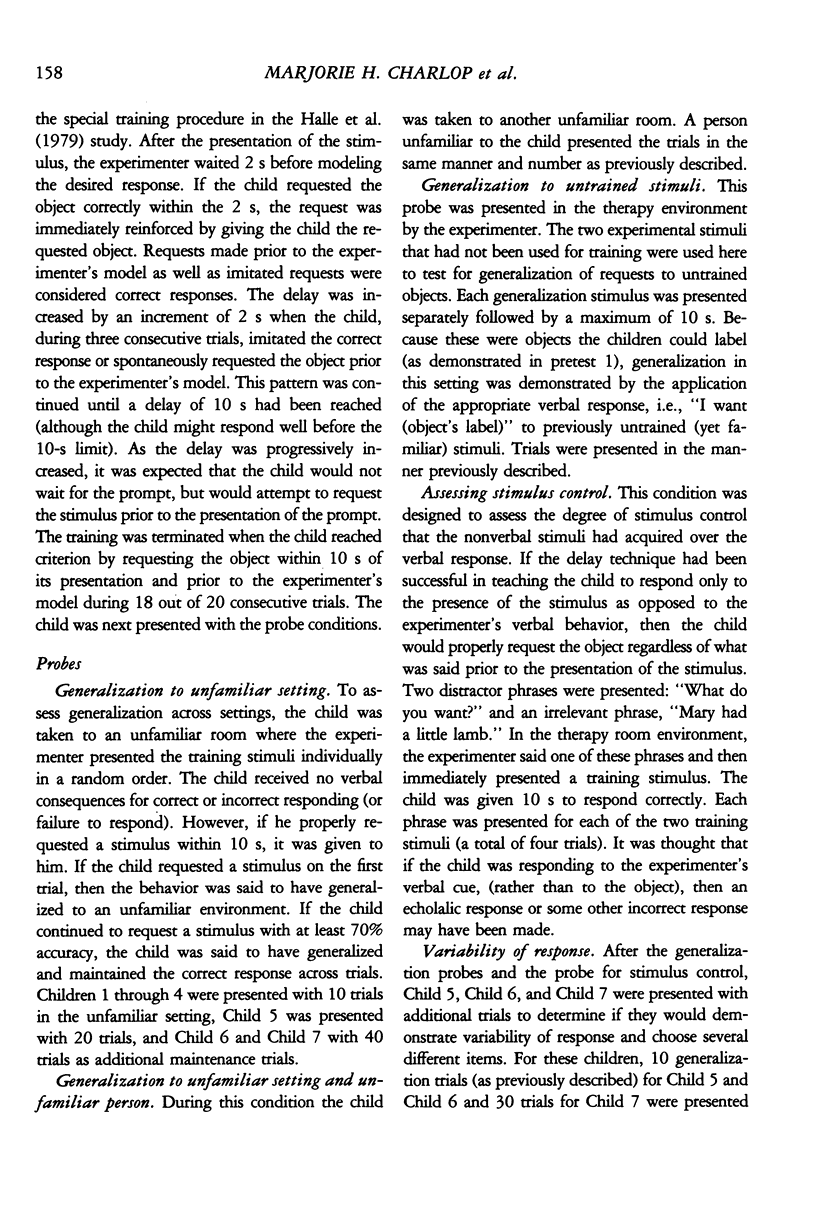
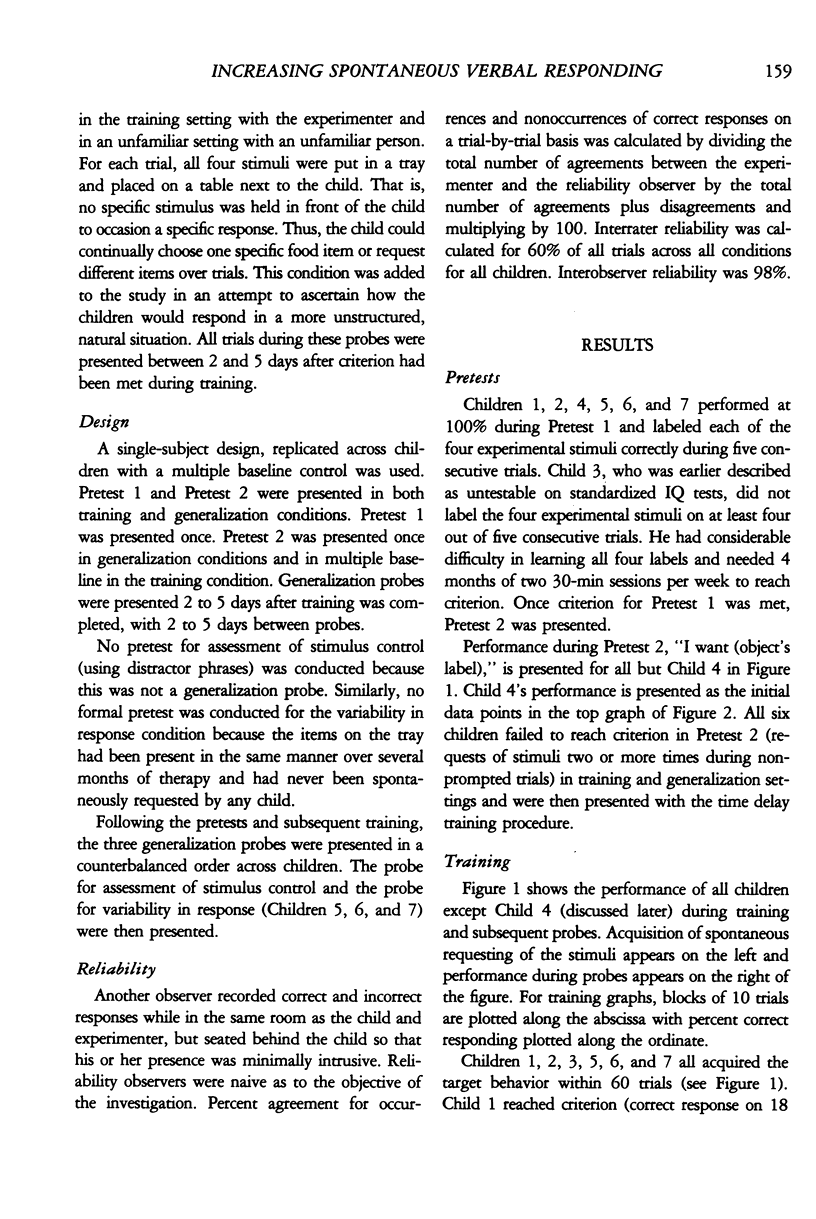
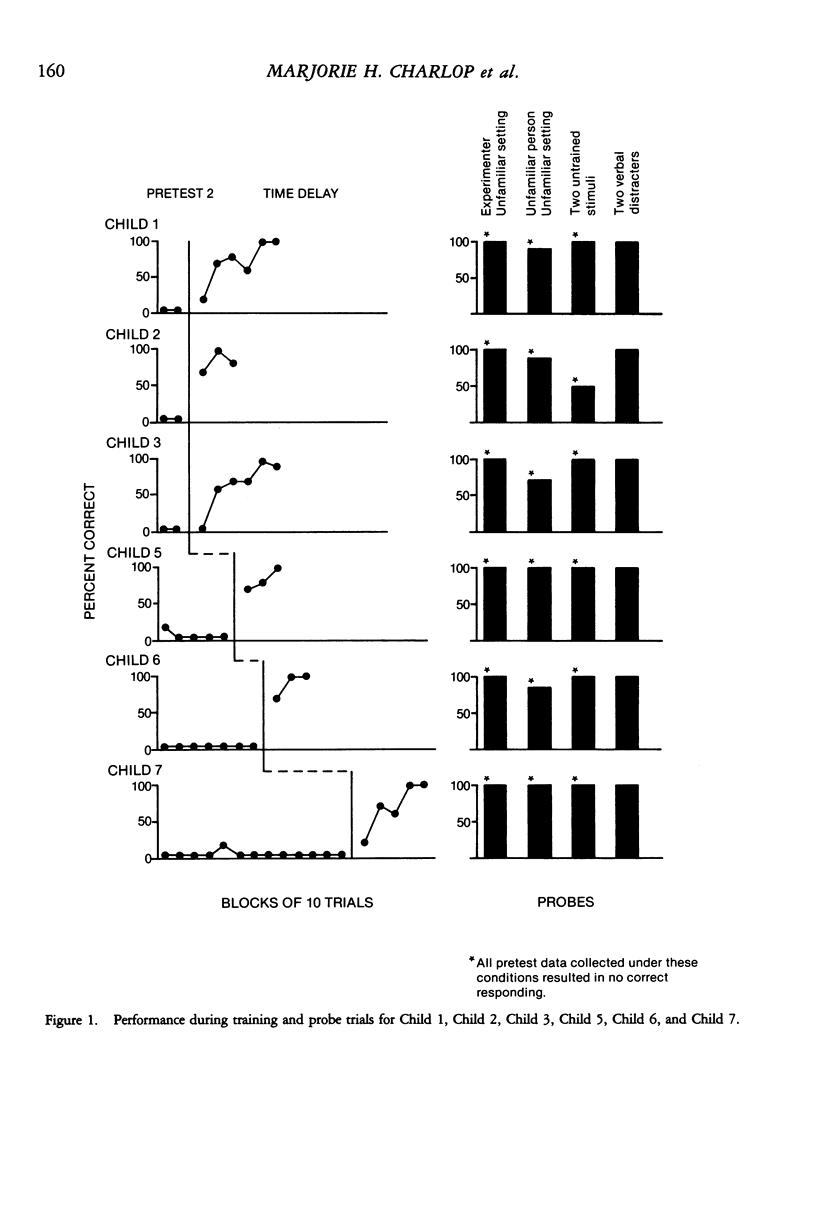

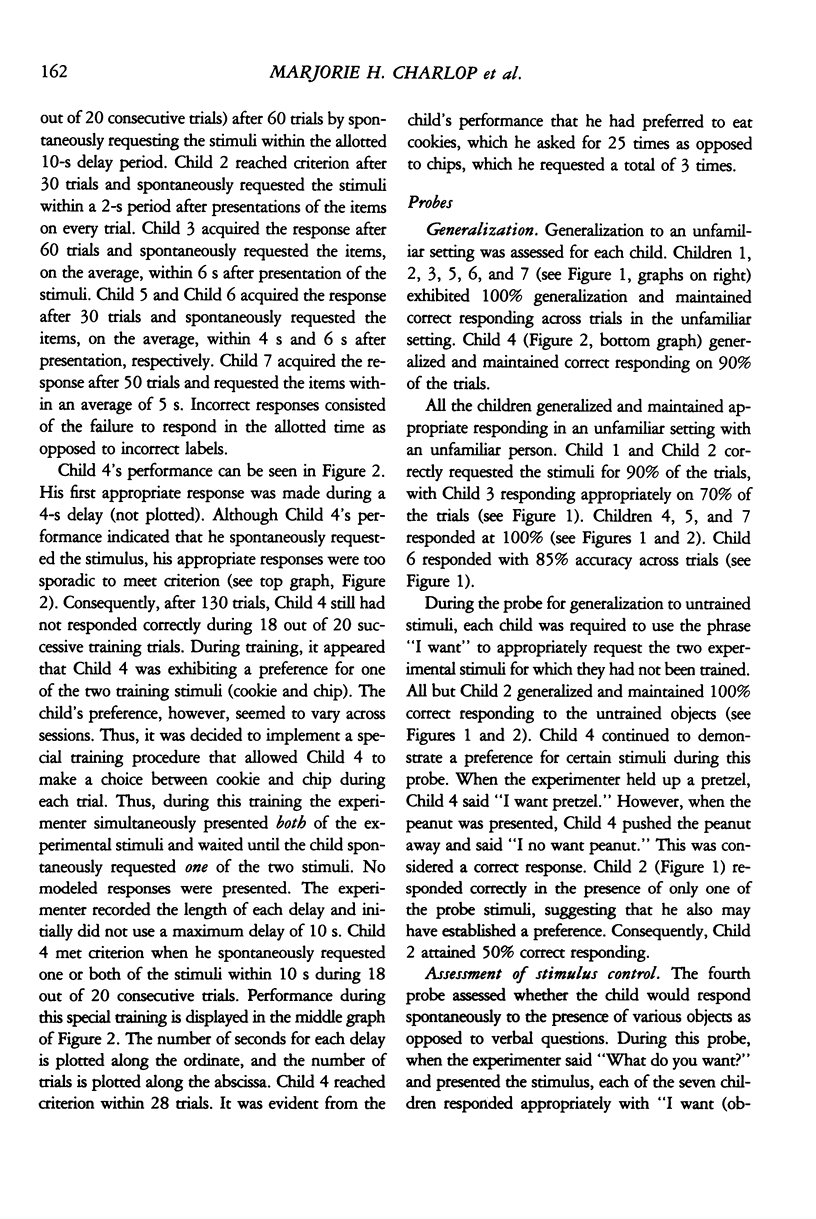
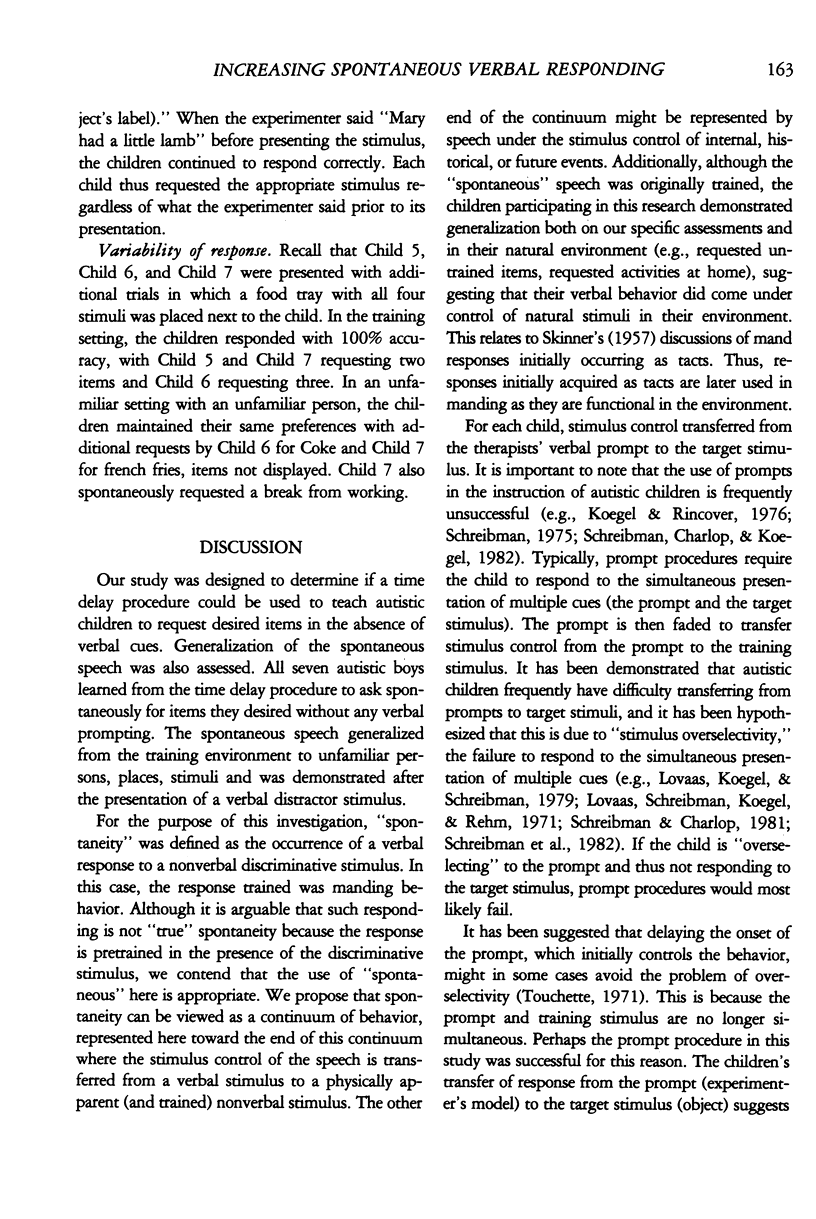
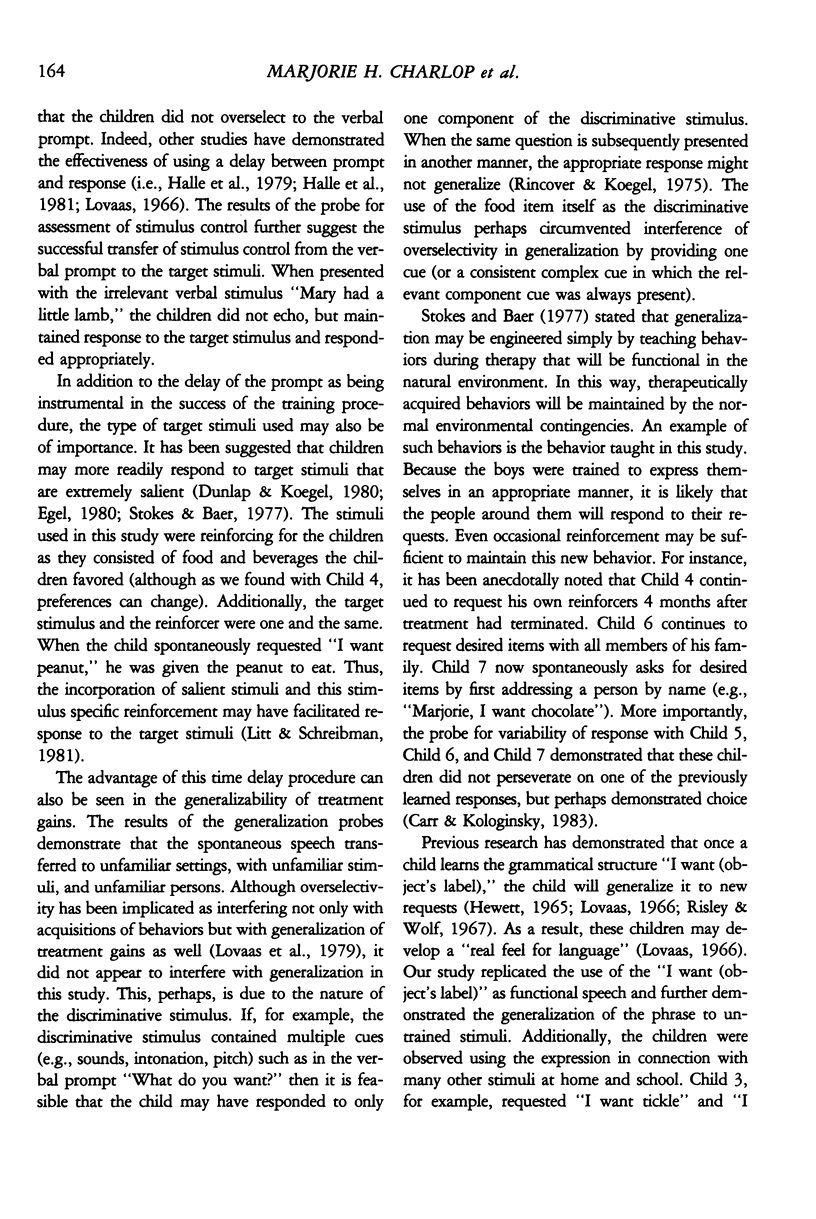
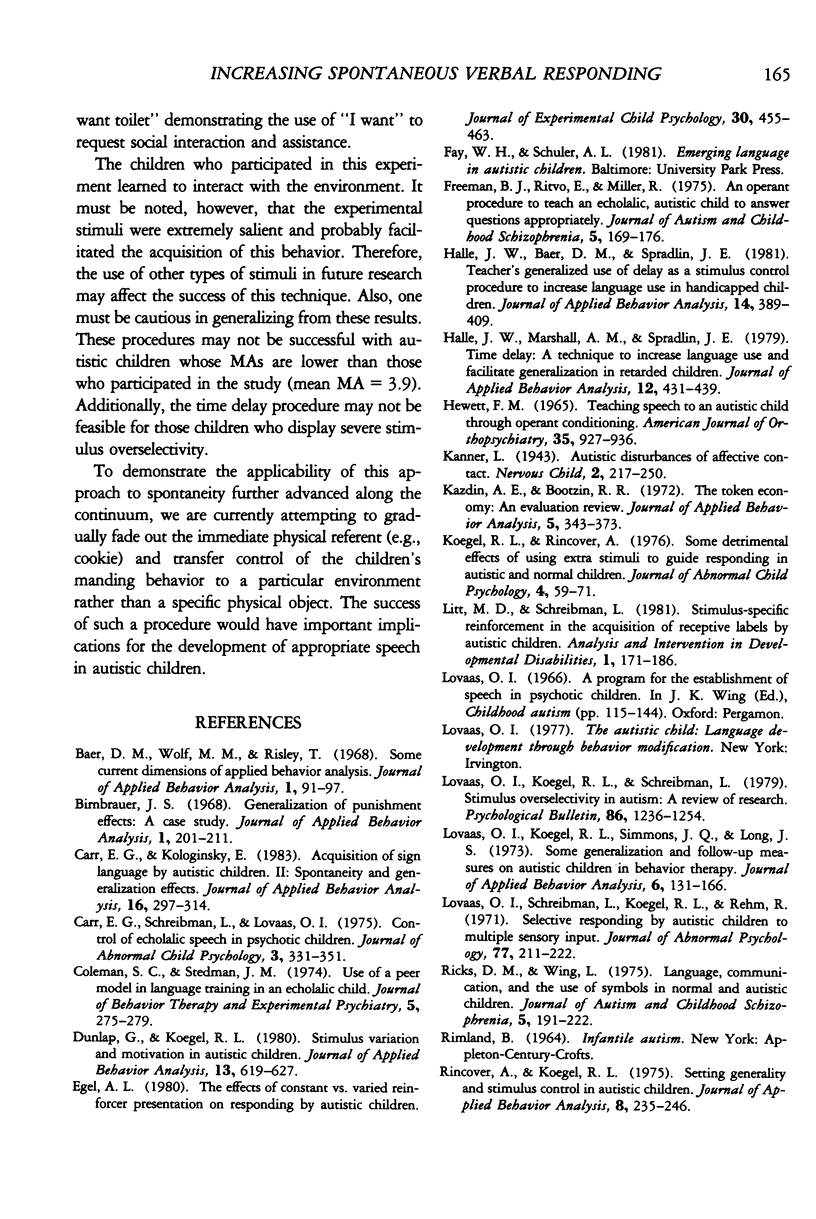

Selected References
These references are in PubMed. This may not be the complete list of references from this article.
- Baer D. M., Wolf M. M., Risley T. R. Some current dimensions of applied behavior analysis. J Appl Behav Anal. 1968 Spring;1(1):91–97. doi: 10.1901/jaba.1968.1-91. [DOI] [PMC free article] [PubMed] [Google Scholar]
- Birnbrauer J. S. Generalization of punishment effects-a case study. J Appl Behav Anal. 1968 Fall;1(3):201–211. doi: 10.1901/jaba.1968.1-201. [DOI] [PMC free article] [PubMed] [Google Scholar]
- Carr E. G., Kologinsky E. Acquisition of sign language by autistic children. II: Spontaneity and generalization effects. J Appl Behav Anal. 1983 Fall;16(3):297–314. doi: 10.1901/jaba.1983.16-297. [DOI] [PMC free article] [PubMed] [Google Scholar]
- Carr E. G., Schreibman L., Lovaas O. I. Control of echolalic speech in psychotic children. J Abnorm Child Psychol. 1975;3(4):331–351. doi: 10.1007/BF00917420. [DOI] [PubMed] [Google Scholar]
- Dunlap G., Koegel R. L. Motivating autistic children through stimulus variation. J Appl Behav Anal. 1980 Winter;13(4):619–627. doi: 10.1901/jaba.1980.13-619. [DOI] [PMC free article] [PubMed] [Google Scholar]
- Egel A. L. The effects of constant vs varied reinforcer presentation on responding by autistic children. J Exp Child Psychol. 1980 Dec;30(3):455–463. doi: 10.1016/0022-0965(80)90050-8. [DOI] [PubMed] [Google Scholar]
- Freeman B. J., Ritvo E., Miller R. An operant procedure to teach an echolalic, autistic child to answer questions appropriately. J Autism Child Schizophr. 1975 Jun;5(2):169–176. doi: 10.1007/BF01537933. [DOI] [PubMed] [Google Scholar]
- Halle J. W., Baer D. M., Spradlin J. E. Teachers' generalized use of delay as a stimulus control procedure to increase language use in handicapped children. J Appl Behav Anal. 1981 Winter;14(4):389–409. doi: 10.1901/jaba.1981.14-389. [DOI] [PMC free article] [PubMed] [Google Scholar]
- Halle J. W., Marshall A. M., Spradlin J. E. Time delay: a technique to increase language use and facilitate generalization in retarded children. J Appl Behav Anal. 1979 Fall;12(3):431–439. doi: 10.1901/jaba.1979.12-431. [DOI] [PMC free article] [PubMed] [Google Scholar]
- Hewett F. M. Teaching speech to an autistic child through operant conditioning. Am J Orthopsychiatry. 1965 Oct;35(5):927–936. doi: 10.1111/j.1939-0025.1965.tb00472.x. [DOI] [PubMed] [Google Scholar]
- Kazdin A. E., Bootzin R. R. The token economy: an evaluative review. J Appl Behav Anal. 1972 Fall;5(3):343–372. doi: 10.1901/jaba.1972.5-343. [DOI] [PMC free article] [PubMed] [Google Scholar]
- Koegel R. L., Rincover A. Some detrimental effects of using extra stimuli to guide learning in normal and autistic children. J Abnorm Child Psychol. 1976;4(1):59–71. doi: 10.1007/BF00917605. [DOI] [PubMed] [Google Scholar]
- Lovaas O. I., Koegel R. L., Schreibman L. Stimulus overselectivity in autism: a review of research. Psychol Bull. 1979 Nov;86(6):1236–1254. [PubMed] [Google Scholar]
- Lovaas O. I., Koegel R., Simmons J. Q., Long J. S. Some generalization and follow-up measures on autistic children in behavior therapy. J Appl Behav Anal. 1973 Spring;6(1):131–165. doi: 10.1901/jaba.1973.6-131. [DOI] [PMC free article] [PubMed] [Google Scholar]
- Lovaas O. I., Schreibman L., Koegel R., Rehm R. Selective responding by autistic children to multiple sensory input. J Abnorm Psychol. 1971 Jun;77(3):211–222. doi: 10.1037/h0031015. [DOI] [PubMed] [Google Scholar]
- National Society for Autistic Children definition of the syndrome of autism. J Autism Child Schizophr. 1978 Jun;8(2):162–169. doi: 10.1007/BF01537864. [DOI] [PubMed] [Google Scholar]
- Ricks D. M., Wing L. Language, communication, and the use of symbols in normal and autistic children. J Autism Child Schizophr. 1975 Sep;5(3):191–221. doi: 10.1007/BF01538152. [DOI] [PubMed] [Google Scholar]
- Rincover A., Koegel R. L. Setting generality and stimulus control in autistic children. J Appl Behav Anal. 1975 Fall;8(3):235–246. doi: 10.1901/jaba.1975.8-235. [DOI] [PMC free article] [PubMed] [Google Scholar]
- Risley T., Wolf M. Establishing functional speech in echolalic children. Behav Res Ther. 1967 May;5(2):73–88. doi: 10.1016/0005-7967(67)90001-0. [DOI] [PubMed] [Google Scholar]
- Rutter M. Diagnosis and definition of childhood autism. J Autism Child Schizophr. 1978 Jun;8(2):139–161. doi: 10.1007/BF01537863. [DOI] [PubMed] [Google Scholar]
- Schreibman L., Carr E. G. Elimination of echolalic responding to questions through the training of a generalized verbal response. J Appl Behav Anal. 1978 Winter;11(4):453–463. doi: 10.1901/jaba.1978.11-453. [DOI] [PMC free article] [PubMed] [Google Scholar]
- Schreibman L., Charlop M. H., Koegel R. L. Teaching autistic children to use extra-stimulus prompts. J Exp Child Psychol. 1982 Jun;33(3):475–491. doi: 10.1016/0022-0965(82)90060-1. [DOI] [PubMed] [Google Scholar]
- Schreibman L., Charlop M. H. S + versus S- fading in prompting procedures with autistic children. J Exp Child Psychol. 1981 Jun;31(3):508–520. doi: 10.1016/0022-0965(81)90033-3. [DOI] [PubMed] [Google Scholar]
- Schreibman L. Effects of within-stimulus and extra-stimulus prompting on discrimination learning in autistic children. J Appl Behav Anal. 1975 Spring;8(1):91–112. doi: 10.1901/jaba.1975.8-91. [DOI] [PMC free article] [PubMed] [Google Scholar]
- Simic J., Bucher B. Development of spontaneous manding in language deficient children. J Appl Behav Anal. 1980 Fall;13(3):523–528. doi: 10.1901/jaba.1980.13-523. [DOI] [PMC free article] [PubMed] [Google Scholar]
- Stokes T. F., Baer D. M. An implicit technology of generalization. J Appl Behav Anal. 1977 Summer;10(2):349–367. doi: 10.1901/jaba.1977.10-349. [DOI] [PMC free article] [PubMed] [Google Scholar]
- Touchette P. E. Transfer of stimulus control: measuring the moment of transfer. J Exp Anal Behav. 1971 May;15(3):347–354. doi: 10.1901/jeab.1971.15-347. [DOI] [PMC free article] [PubMed] [Google Scholar]
- Wahler R. G. Setting generality: some specific and general effects of child behavior therapy. J Appl Behav Anal. 1969 Winter;2(4):239–246. doi: 10.1901/jaba.1969.2-239. [DOI] [PMC free article] [PubMed] [Google Scholar]
- Walker H. M., Buckley N. K. Programming generalization and maintenance of treatment effects across time and across settings. J Appl Behav Anal. 1972 Fall;5(3):209–224. doi: 10.1901/jaba.1972.5-209. [DOI] [PMC free article] [PubMed] [Google Scholar]


